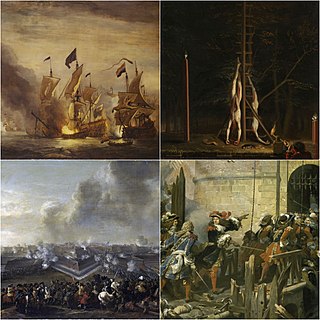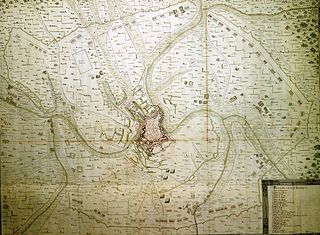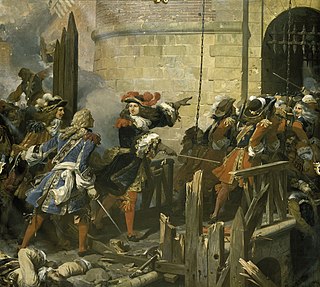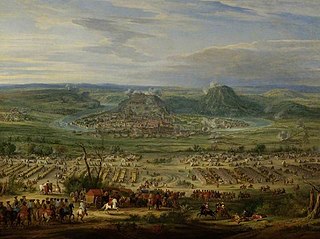
Henri de La Tour d'Auvergne, vicomte de Turenne, commonly known as Turenne, was a French general and one of only six Marshals to have been promoted Marshal General of France. The most illustrious member of the La Tour d'Auvergne family, his military exploits over his five-decade career earned him a reputation as one of the greatest military commanders in history.

The War of Devolution took place from May 1667 to May 1668. In the course of the war, France occupied large parts of the Spanish Netherlands and Franche-Comté, both then provinces of the Holy Roman Empire ruled by Spain. Its name derives from an obscure law known as the Jus Devolutionis, used by Louis XIV to claim that these territories had "devolved" to him by right of marriage to Maria Theresa of Spain.

The Franco-Dutch War was a European conflict that lasted from 1672 to 1678. Its primary belligerents were France, backed at different times by Münster, Cologne, England, and the Swedish Empire, and the Dutch Republic, allied with the Holy Roman Empire, Spain, Brandenburg-Prussia and Denmark-Norway. The 1672 to 1674 Third Anglo-Dutch War and 1675 to 1679 Scanian War are considered related conflicts.

Louis François de Boufflers, Duke of Boufflers was a prominent French soldier in the age of Louis XIV of France. He was created count of Cagny and duke of Boufflers and named marshal of France. He was famed for his excellent defensive leadership during the sieges of Namur and Lille, next to his conduct during the Battle of Malplaquet.

The siege of Maastricht took place from 13 to 30 June 1673 during the Franco-Dutch War of 1672 to 1678, when a French army captured the Dutch fortress of Maastricht. The city occupied a key strategic position on the Meuse river and its capture was the main French objective for 1673. It was returned to the Dutch under the terms of the 1678 Treaty of Nijmegen.

François de Blanchefort de Créquy, later Marquis de Marines, was a 17th-century French noble and soldier, who served in the wars of Louis XIV of France.

The siege of Lille took place during the War of Devolution. Louis XIV's forces besieged Lille from 10 August to 28 August 1667. It was the only major engagement of the war. Lille was the first major victory for Vauban’s siege techniques. Louis XIV, arguing that the Spanish dowry of his wife Maria Theresa of Spain had not been paid, began to expand French borders to the north and east, invading the Spanish Netherlands. This began a conflict with Spain that became the War of Devolution. After taking Charleroi, Tournai and Douai, French troops laid siege to Lille, at that time part of the county of Flanders under Spanish rule. Siege techniques applied by the French military engineer Vauban were instrumental in their capture.

The siege of Namur, 25 May–30 June 1692, was a major engagement of the Nine Years' War, and was part of the French grand plan to defeat the forces of the Grand Alliance and bring a swift conclusion to the war. Namur, sitting on the confluence of the Meuse and Sambre rivers, was a considerable fortress, and was a significant political and military asset. French forces, guided by Vauban, forced the town's surrender on 5 June, but the citadel, staunchly defended by Menno van Coehoorn, managed to hold on until 30 June before capitulating, bringing an end to the 36-day siege. Concerned that King William III planned to recapture the stronghold, King Louis XIV subsequently ordered his commander-in-chief, the duc de Luxembourg, to join battle with the Allies in the field, resulting in the bloody Battle of Steenkerque on 3 August.

The siege of Mons, 15 March – 10 April 1691, was a major operation fought during the Nine Years' War, and was the main French objective for the 1691 campaign in the Spanish Netherlands. The city was besieged and captured before the normal commencement of the campaigning season with minimal losses. The outcome was not in doubt, but in a conflict dominated by siege warfare, neither the French army of King Louis XIV, nor the forces of the Grand Alliance under King William III, could bring about a decisive battle. After the siege the duc de Boufflers bombarded the neutral city of Liège, whilst the duc de Luxembourg captured Halle, and scored a minor victory against the Prince of Waldeck at the Battle of Leuze in September. Strategically, however, little had changed in the war, and both combatants returned to winter quarters at the end of the campaigning season.

The siege of Luxembourg, in which Louis XIV of France laid siege to the Spanish-controlled Fortress of Luxembourg from 27 April to 7 June 1684, was the most significant confrontation of the War of the Reunions between France and Spain. The action caused alarm among France's neighbours and resulted in the formation of the League of Augsburg in 1686. In the ensuing war France was forced to give up the duchy, which was returned to the Habsburgs by the Treaty of Ryswick in 1697.

The siege of Valenciennes took place from 28 February to 17 March 1677, during the Franco-Dutch War, when Valenciennes, then in the Spanish Netherlands, was attacked by a French army under the duc de Luxembourg.

The Battle of Valenciennes was fought on 16 July 1656 between the Spanish troops commanded by John Joseph of Austria and the French troops under Henri de la Tour d'Auvergne, Vicomte de Turenne, in the outskirts of the city of Valenciennes in the Spanish Netherlands during the Franco-Spanish War. After a period of Spanish recovery following the Peace of Münster in 1648, France went again on the offensive in 1654, having succeeded in suppressing internal rebellions, and took several towns in the province of Hainaut over the course of two years. On early 1656, Turenne was instructed by the French court to continue the offensive. He intended at first to besiege Tournai, but realising that it had been strongly reinforced by the Army of Flanders under the newly appointed John Joseph of Austria, illegitimate son of Philip IV of Spain, he went instead to besiege Valenciennes, in the course of the Scheldt River.

The siege of Besançon took place from 25 April to 22 May 1674 during the Franco-Dutch War, when French forces nominally led by Louis XIV of France invaded Franche-Comté, then part of the Spanish Empire.

The siege of Dunkirk in 1658 was a military operation by France and the Commonwealth of England intended to capture the fortified port city of Dunkirk, Spain's greatest privateering base, from a Spanish garrison strengthened with English Royalists and French Fronduers. Dunkirk was a strategic port on the southern coast of the English Channel in the Spanish Netherlands that had often been a point of contention previously and had changed hands a number of times. Privateers operating out of Dunkirk and other ports had cost England some 1,500 to 2,000 merchant ships in the past year. The French and their English Commonwealth allies were commanded by Marshal of France Turenne. The siege would last a month and featured numerous sorties by the garrison and a determined relief attempt by the Spanish army under the command of Don Juan of Austria and allied English Royalists led by Duke of York and rebels of the French Fronde under the Great Condé that resulted in the battle of the Dunes.

The siege of Ath was a siege of the Nine Years' War. The French stockpiled 266,000 French pounds of gunpowder for the siege and used less than half of it. Consumption of other material amounted to 34,000 pounds of lead, 27,050 cannonballs, 3,400 mortar bombs, 950 grenades and 12,000 sandbags. The financial costs were 89,250 French livres. After the garrison's capitulation, 6,000 peasant workers filled up the trenches. Of the 62 French engineers present, two were killed and seven seriously wounded. This demonstration of French military potency, combined with the successful storming of Barcelona the same year, convinced the Allies to come to terms with France in the treaty of Ryswick, thus ending the war.

Charles de Montsaulnin, Comte de Montal (1619–1696) was a 17th-century French military officer and noble who was a close friend of Le Grand Condé, and fought in many of the wars of Louis XIV of France.

The siege of Naarden took place from 6 to 13 September 1673 during the Franco-Dutch War of 1672 to 1678, when a Dutch army captured the Dutch fortress town of Naarden. Naarden had been occupied by the French since the previous year.

The siege of Grave took place from 25 July to 27 October in 1674 during the Franco-Dutch War of 1672 to 1678, when a Dutch army captured the Dutch fortress town of Grave in what is now North Brabant. Grave had been occupied by the French since the summer of 1672 when an army under Turenne forced the town to surrender.

The siege of Tournai was a siege of the city of Tournai, then part of the Kingdom of France, between 28 June and 3 September 1709. A Grand Alliance army under the British Duke of Marlborough successfully forced the surrender of the French garrison during the War of the Spanish Succession.

The siege of Mons took place between 19 September and 23 October 1709 during the War of the Spanish Succession. It saw a Franco-Spanish garrison in the fortified town of Mons, then in the Spanish Netherlands, besieged by a force of the Duke of Marlborough's Grand Alliance army under the command of the Prince of Orange.





















